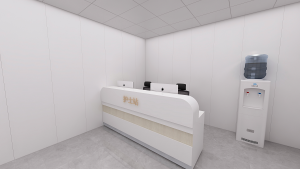Hospital furniture, also known as medical furniture, is a new concept in recent years. Until the 1980s, the furniture of the medical system was not much different from that of ordinary furniture. With the development of medical technology in the 20th century, people began to pay attention to the function of hospital furniture and the design of indoor and outdoor space environment construction. At that time, European and American countries first paid attention to the functional development of hospital furniture, and then from the 1990s, the industry related to hospital furniture in China also began to emerge.
Compared with other civil furniture, the design of medical furniture has higher requirements in safety, humanization, corrosion resistance, wear resistance and durability. So, how to design medical furniture in line with market demand? Combining the development trend of medical furniture design at home and abroad, we can summarize the following six design principles.

Safety principle
Compared with healthy people and other environments, hospitals should pay more attention to the stable structure, strong structure and no acute Angle risk factors of medical furniture. At the same time, the design of medical furniture products must be easy to clean, so as to effectively prevent and control nosocomial infection.
Functional principle
The functional design of medical furniture includes material function design and spiritual function design.
Material function design: refers to the product itself needs to meet the use of function design, such as sitting, lying, rely on, storage and other functions, should also consider processing technology, industrial production and facilitate handling, stacking, folding, disassembly and other design.
Spiritual function design: it is to meet people’s psychological needs, so that people feel happy when using, so that patients from the psychological and spiritual level to relieve the tension.
Principle of environmental protection
Medical furniture is closely related to people’s health, and green environmental protection is the primary criterion for evaluating qualified medical furniture. Therefore, the environmental protection of medical furniture should be considered from the life cycle of product design, material selection, production, transportation, installation, use and scrapping.
1. Material selection: material selection must comply with the corresponding national testing standards, Reduce free formaldehyde content in materials, Reduce harmful substances in furniture, and comply with the “3R” concept of Reduce, Reuse and Recycle.
2. Processing process: In the processing process of medical furniture, in addition to considering the low pollution, low energy consumption and convenient processing of materials and processing to the environment, it should also consider its structure and technology. Avoid secondary pollution of materials and products caused by harmful substances such as formaldehyde in the process of processing.
Adaptability principle
Adaptability refers to the design of hospital furniture from the perspective of meeting the needs of the whole life cycle of medical facilities, so as to meet the needs of future hospital development. Therefore, medical furniture adopts modular and standardized design to improve the expansibility of its products, flexibly realize the splicing of different shapes, improve the production efficiency and quality of products, and save costs.
The principle of spatial matching
Medical space is a kind of medical space composed of architectural space, medical furniture and medical facilities. The size, lighting, temperature, ventilation, sound, type and location of medical furniture, color and material of each space should be reasonably arranged. Hospital furniture is humanized concept design in accordance with the overall hospital space environment, has reached the integration of hospital building space as a whole, showing the characteristics of each hospital, comfort, relieve the tension of patients seeking medical treatment, reduce the work pressure of medical staff. Avoid the hospital indoor environment cramped and urgent, monotonous, unpleasant odor further expand the burden of aggravating the patient’s heart. Here, attention should be paid to the design of hospital furniture, which should be integrated with the two aspects of hospital building environment space and hospital medical concept, so as to achieve a comfortable and personalized effect.
Humanization principle
The design concept of “people-oriented” has become a design trend. As the equipment in close contact with patients in the diagnosis and treatment environment, the humanized design of medical furniture is particularly important. The humanized design of medical furniture is not only convenient for the use of doctors and patients, but also will better improve the hospital’s healing environment and diagnosis and treatment services.
Medical furniture should meet the requirements of humanization, the first step is to carry out ergonomic design, which must meet the requirements of doctors and patients. For example, the edges and corners should be changed to rounded corners, handrails should be designed to facilitate patients to stand up, etc. At the same time, the tone should be more harmonious, but also safe.
